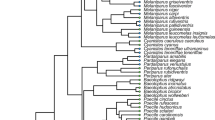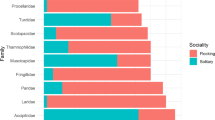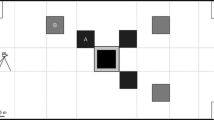Summary
Feeding rates of five captive red crossbills (Loxia curvirostra) were measured when they were foraging alone, and in flocks of two or four on three seed dispersion patterns. On the most strongly clumped seed dispersion, individuals had higher mean feeding rates and the smallest probability of starvation when in flocks of two than when alone or in flocks of four. Individuals in flocks of four had higher feeding rates on the weakly clumped seed dispersion than on the uniform and more clumped seed dispersions; there were no food finding benefits gained from flocking on the uniform seed dispersion and aggression increased as food became more clumped. Most recent work has assumed that flocking results in higher feeding rates only because time spent vigilant is reduced. Crossbills, however, did not visit more cones per unit time as flock size increased, as would be expected if less time was spent vigilant. Thus, any reductions in vigilance as flock size increased were countered by increases in other behaviours, such as those related to aggression. Consequently, the higher mean feeding rates of crossbills in flocks than when solitary is not attributable to reduced vigilance. The increase in mean and the decline in variance of feeding rates occurred because crossbills in flocks found good patches earlier, and possible by spending less time assessing poor patches.
Similar content being viewed by others
References
Baker MC, Belcher CS, Deutsch LC, Sherman GL, Thompson DB (1981) Foraging success in junco flocks and the effects of social hierarchy. Anim Behav 29:137–142
Benkman CW (1987) Food profitability and the foraging ecology of crossbills. Ecol Monogr 57:251–267
Benkman CW (1988) Intake rate maximization and the foraging behaviour of crossbills. Ornis Scand (in press)
Caraco T (1979) Time budgeting and group size: A test of theory. Ecology 60:618–627
Caraco T (1981) Risk-sensitivity and foraging groups. Ecology 62:527–531
Caraco T, Martindale S, Pulliam HR (1980) Avian flocking in the presence of a predator. Nature (London) 285:400–401
Caraco T, Pulliam HR (1984) Sociality and survivorship in animals exposed to predation. In: Price PW, Slobodchikoff CN, Gaud WS (eds) A new ecology: Novel approaches to interactive systems. Wiley & Sons, New York, pp 279–309
Charnov EL (1976) Optimal foraging: the marginal value theorem. Theor Popul Biol 9:129–136
Clark CW, Mangel M (1984) Foraging and flocking strategies: information in an uncertain environment. Am Nat 123:626–641
Clark CW, Mangel M (1986) The evolutionary advantages of group foraging. Theor Popul Biol 30:45–75
Ekman J, Rosander B (1987) Starvation risk and flock size of the social forager: when there is a flocking cost. Theor Popul Biol 3:167–177
Ewald PW (1986) Influence of asymmetries n resource quality and age on aggression and dominance in black-chinned hummingbirds. Anim Behav 33:705–719
Glück E (1987) Benefits and costs of social foraging and optimal flock size in goldfinches (Carduelis carduelis). Ethology 74:65–79
Knight SK, Knight RL (1986) Vigilance patterns of bald eagles feeding in groups. Auk 103:263–272
Krebs JR (1974) Colonial nesting and social feeding as stategies of exploiting food resources in the great blue heron (Ardea herodias). Behaviour 51:99–134
Krebs JR (1979) Foraging strategies and their social significance. In: Marler PR, Vandenbergh JG (eds) Social behavior and communication. Plenum Press, New York, pp 225–270
Krebs JR, MacRoberts MH, Cullen JM (1972) Flocking and feeding in the great tit Parus major — An experimental study. Ibis 114:507–530
Lendrem DW (1984) Flocking, feeding and predation risk: absolute and instantaneous feeding rates. Anim Behav 32:298–299
Newton I (1967) The adaptive radiation and feeding ecology of some British finches. Ibis 109:33–98
Pulliam HR (1973) On the advantage of flocking. J theor Biol 38:419–422
Pulliam HR (1976) The principles of optimal behaviour and the theory of communities. In: Bateson PPG, Klopfer PH (eds) Perspectives in ethology, vol III. Plenum Press, New York, pp 311–332
Pulliam HR, Millikan GC (1982) Social organization in the nonbreeding season. In: Farner DS, King JR, Parkes KC (eds) Avian biology, vol VI. Academic Press, New York, pp 169–197
Pulliam HR, Pyke GH, Caraco T (1982) The scanning behavior of juncos: A game-theoretical approach. J theor Biol 95:89–103
Schaller GB (1972) The Serengeti lion. University Chicago Press, Chicago
Stephens DW, Charnov EL (1982) Optimal foraging: some simple stochastic models. Behav Ecol Sociobiol 10:251–263
Stephens DW, Krebs JR (1986) Foraging Theory. Princeton University Press, Princeton
Sullivan KA (1984) The advantages of social foraging in downy woodpeckers. Anim Behav 32:16–22
Thompson WA, Vertinsky I, Krebs JR (1974) The survival value of flocking in birds: a simulation model. J Anim Ecol 43:785–820
Tordoff HB (1954) Social organization and behavior in a flock of captive, nonbreeding red crossbills. Condor 56:346–358
Walsberg GE (1983) Avian ecological energetics. In: Farner DS, King JR, Parkes KC (eds) Avian biology, vol VII. Academic Press, New York, pp 161–220
Author information
Authors and Affiliations
Rights and permissions
About this article
Cite this article
Benkman, C.W. Flock size, food dispersion, and the feeding behavior of crossbills. Behav Ecol Sociobiol 23, 167–175 (1988). https://doi.org/10.1007/BF00300351
Received:
Accepted:
Issue Date:
DOI: https://doi.org/10.1007/BF00300351




